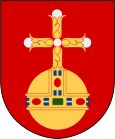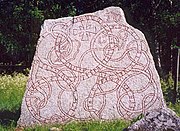Uppland
| Uppland | |
|---|---|

|

|
| Basic data | |
| Part of the country (landsdel) : | Svealand |
| Province (län) : | Uppsala County , Stockholm County , Västmanland County |
| Surface: | 13,717 km² |
| Residents: | 1,409,607 (December 31, 2008) |
| Population density: | 99 inhabitants per km² |
| Highest elevation: | Tallmossen 118 m ö.h. |
| Largest lake: | Tämnaren |
Uppland is the most populous historical province ( Swedish landskap , hence the often used translation "landscape") in Sweden . Uppland lies on the Baltic Sea and consists of today's province of Uppsala län , the northern part of the province of Stockholm län and smaller parts of the provinces Gävleborgs län , Södermanland län and Västmanland län .
In Uppland are the cities of Enköping , Norrtälje , Sigtuna , Uppsala , Vaxholm . The northern part of Stockholm is also part of Uppland.
geography
Uppland is a slightly hilly flat land, the highest elevations of which rise up to 50 meters in the middle and north, up to 70 meters in the southeast and up to 100 meters in the west. In the part of Lake Mälaren that belongs to Uppland there are a large number of islands. The Baltic Sea coast has many bays and is bordered by the northern part of the Stockholm archipelago . In the area of the city of Uppsala there is a larger plain that is used for agriculture. Stony and swampy terrain is often found in the north.
The subsoil is formed by an ancient mountain range that is millions of years old, which first broke apart through several faults and was later abraded by the inland ice . During the retreat, the ice deposited the material it had carried with it as moraines . The so-called “ Rollsteinrücke ” (rullstensåsar) , which characterize the landscape today, were created. In some places these ridges are covered with layers of clay up to 100 meters thick. These emerged after the Ice Age when the area was covered by the sea. After that, the postglacial land uplift began and the land mass rose again from the sea.
history
Based on the existing archaeological and geological studies, it is assumed that Uppland was settled more than 5000 years ago from the western regions of Västmanland and Närke . Mainly bank areas were settled, which today are inland due to the uplift of the land. Some of the objects found indicate that there was already a brisk trade between Uppland and Åland as well as Finnish regions back then. The finds from the Bronze Age testify to increasing prosperity and an expansion of trade relations. In addition to Upland products, bronze vessels from southern Scandinavia and southern Europe were found. Various stone carvings also date from the Bronze Age .
There are only a few, but perfectly formed finds from the older Iron Age. On the other hand, several metal, coin and glass treasures were discovered from the following period, which testify that Uppland had connections that reached both to Constantinople and France . The grave goods in boat graves with abundant Germanic ornamentation have become known . These gave the epoch between the years 550 and 800 the name Vendelzeit , as they were mainly found in the Vendel region north of Uppsala. Upplands, and perhaps all of Scandinavia, is the most important find spot in Birka with its numerous objects from the Viking Age . During this time the Uppland inhabitants were called rôs in Greece and ruotsi in Finland , which meant something like "the rowing people" and is reflected today in the name of the Roslagen region on the Uppland coast.

The rune stones in the region date mainly from the 11th century. Uppland has more of these than any other historic province in Sweden. At the beginning of the 20th century, around 950 rune stones had been registered, but many of the unregistered ones had previously been destroyed or were used as building material for the construction of churches. Many stones can be traced back to the rune stone scratcher Asmund Kareson , who lived around 1025 and was the first to decorate the stones with artistic ornaments. At the time when the first written sources appeared, which are not clearly verifiable today, Uppland consisted of three to four provinces: Fjärhundraland in the west, Tiundaland in the center with Alt-Uppsala as the main town, Attundaland in the east and possibly Roden in the north, which sometimes was also counted to Attundaland. The Hillersjö runestone is a source of evidence that women played an important role in the line of succession.
Under King Erik IX. the Christian religion established itself in Uppland and Erik's heirs proselytized Finnish areas. Even if Uppland later no longer had the dominant position in Sweden, important events such as the king's election at the Stone of Mora took place in this landscape. The relocation of the archbishop's seat to Uppsala in 1164 was also significant . In the battles of the following years, the church and several aristocrats acquired large estates in Uppland. These stood on the side of the kings in the Kalmar Union , while the common people took part in revolts such as the Engelbrekt uprising . Later, the princes were able to bring large parts of the population to their side, but the others maintained their position, and so it was that in the battle of brunkeberg (10 October 1471) uppländische farmers on the side of Sten Sture the Elder against their countrymen, who were on Christian I's side, fought. After Sten Stures victory, the nobles and the peasants associated with them switched to his side and from that time on belonged to the adversaries of the Danish rulers, even if they suffered some heavy losses during Gustav Wasa's liberation campaign.
Due to the Reformation almost all parishes in Uppland became Protestant in a short time. When the Counter-Reformation began, the church dignitaries met at the initiative of Duke Karl on February 25, 1593 for the Synod of Uppsala (Uppsala may) and signed a document in which they stipulated that Luther's teaching was the applicable teaching for the country. The region flourished in the 17th century. This was mainly evident in the expansion of Uppsala University , the construction of new castles and improved ironworking. On the other hand, the beginning of the 18th century with the Great Northern War , when Russian troops devastated vast coastal areas in 1719, and the poor harvests of 1708 brought severe burdens for the local population. After the war ended, there was no further fighting in Uppland and the economy recovered.
Landscape symbols
- Flower: checkerboard flower
- Animal: white-tailed eagle
- Vogel: Great Crested Grebe
- Fish: asp
literature
- Uppland . In: Theodor Westrin, Ruben Gustafsson Berg, Eugen Fahlstedt (eds.): Nordisk familjebok konversationslexikon och realencyklopedi . 2nd Edition. tape 30 : Tromsdalstind – Urakami . Nordisk familjeboks förlag, Stockholm 1920, Sp. 1188 (Swedish, runeberg.org ).
Web links
- Official website (various languages)
Individual evidence
- ↑ Folkmängd i landskapen ( Memento from August 17, 2013 in the Internet Archive )
- ^ Rudolf Simek: The Vikings. CH Beck Knowledge series. CH Beck Munich, 6th edition, 2016, p. 100; “Geirmund married Gerlaug when she was a girl, they had a son before Geirmund drowned and the son died. Then she married Gudrik and they had children, but only one girl survived, her name was Inga. She married Ragnfast von Snottsta, then the latter died and her son died and Inga inherited her son. Then she married Eirik [he must have died too]. She died there, and Geirlaug inherited her daughter Inga. "
